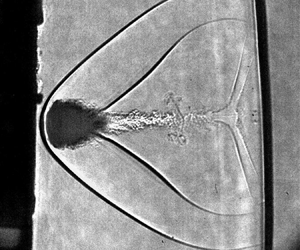Published online by Cambridge University Press: 23 December 2024

In this paper, aerobreakup in the stagnation region of high-Mach-number flow over a bluff body is studied with experiments and computations. Water drops of diameter 0.51–2.30 mm were acoustically levitated at sea level along the flight path of a rectangular  $100\ {\rm mm} \times 150\ {\rm mm}$ rail-gun launched projectile. This enabled the study of aerobreakup at high Mach (3.03–5.12), post-shock Mach (1.5–1.9), Weber
$100\ {\rm mm} \times 150\ {\rm mm}$ rail-gun launched projectile. This enabled the study of aerobreakup at high Mach (3.03–5.12), post-shock Mach (1.5–1.9), Weber  $(5 \times 10^4\unicode{x2013}4 \times 10^5)$ and Reynolds
$(5 \times 10^4\unicode{x2013}4 \times 10^5)$ and Reynolds  $(6 \times 10^4\unicode{x2013}3 \times 10^5)$ numbers. High-speed backlit shadowgraphy is used to record the flow structure. Computations are made for two cases, and it was found that the drop behaviour is not dominated by viscous or surface-tension effects and can be adequately captured by treating the gas as calorically perfect with the ratio of specific heats set to 1.3 to account for thermochemical effects. To assess drop surface stability at early breakup times, results from Newton's inclination method are used to determine the flow along the drop surface and input to a linear-stability analysis; from this, it was found that viscosity and surface tension can be neglected. Moreover, the acceleration term dominates the shear term at the stagnation point, a point accentuated as a drop flattens; this relation inverts closer to the drop equator. Linear-stability analysis was insufficient for modelling late-stage aerobreakup because the predicted wavelengths were too small and the expected aerobreakup times were non-physically short. To address this discrepancy, a nonlinear instability model with constant-rate growth is used that treats the accelerated drop surface as analogous to bubbles rising through a liquid; agreement with computations is good.
$(6 \times 10^4\unicode{x2013}3 \times 10^5)$ numbers. High-speed backlit shadowgraphy is used to record the flow structure. Computations are made for two cases, and it was found that the drop behaviour is not dominated by viscous or surface-tension effects and can be adequately captured by treating the gas as calorically perfect with the ratio of specific heats set to 1.3 to account for thermochemical effects. To assess drop surface stability at early breakup times, results from Newton's inclination method are used to determine the flow along the drop surface and input to a linear-stability analysis; from this, it was found that viscosity and surface tension can be neglected. Moreover, the acceleration term dominates the shear term at the stagnation point, a point accentuated as a drop flattens; this relation inverts closer to the drop equator. Linear-stability analysis was insufficient for modelling late-stage aerobreakup because the predicted wavelengths were too small and the expected aerobreakup times were non-physically short. To address this discrepancy, a nonlinear instability model with constant-rate growth is used that treats the accelerated drop surface as analogous to bubbles rising through a liquid; agreement with computations is good.